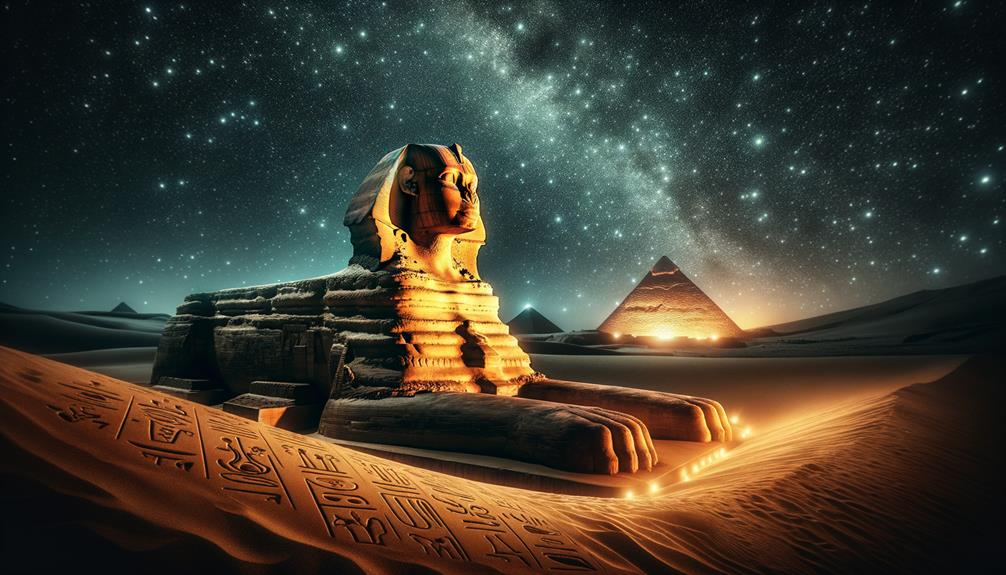The Sphinx, that mysterious guard of the Giza Plateau, has certainly sparked more intense discussions and wild guesses than any other ancient structure in the world. As I look at the heap of theories, it's impossible not to be amazed at the range of interpretations and the persistence of human imagination. From claims of extraterrestrial builders to ideas about secret rooms hiding priceless treasures, the Sphinx truly acts as a drawing board for our most profound questions and wildest fantasies. But let's peel back the myths and guesswork, and aim to comprehend this awe-inspiring structure in its historical and cultural setting. Who were the real builders, and what was their motivation? What function did it serve? And why, over countless centuries, does it still draw our attention? Let's kick off this journey of learning, and maybe in the process, we'll realize that the truth is just as intriguing as the myth.
Unveiling the Sphinx Origins

Let's dig into the origins of the Sphinx, a tale as grand and intricate as the statue itself. Standing tall at 66 feet and stretching out 240 feet, this behemoth is entirely carved from limestone. Commonly known as the Great Sphinx of Giza, it's an ancient wonder filled with unsolved riddles that continue to rivet both researchers and curiosity seekers.
Historians theorize the Sphinx was the brainchild of Pharaoh Khafre, making it a critical piece of Ancient Egypt's cultural and mythological tapestry. Yet, despite these insights, we're still scratching our heads over the original name and true symbolism of the Sphinx. There's no shortage of theories, but solid answers are hard to come by.
Adding a dash of intrigue, there's evidence that the Great Sphinx once sported a coat of paint. Faint remnants of red, blue, and yellow hues cling to its weather-beaten face, suggesting a once colorful exterior. This discovery only deepens the mystery of the Sphinx and emphasizes the need for continued study into its roots.
Looking into the Sphinx's origins isn't a walk in the park. It calls for a delicate mix of archaeological sleuthing and historical interpretation. Think of it as a 57-piece puzzle, with each piece playing a crucial role in revealing the full image. But for now, the Sphinx stands as a timeless icon of the ancient world's ingenuity and enigma.
Decoding the Sphinx Riddles
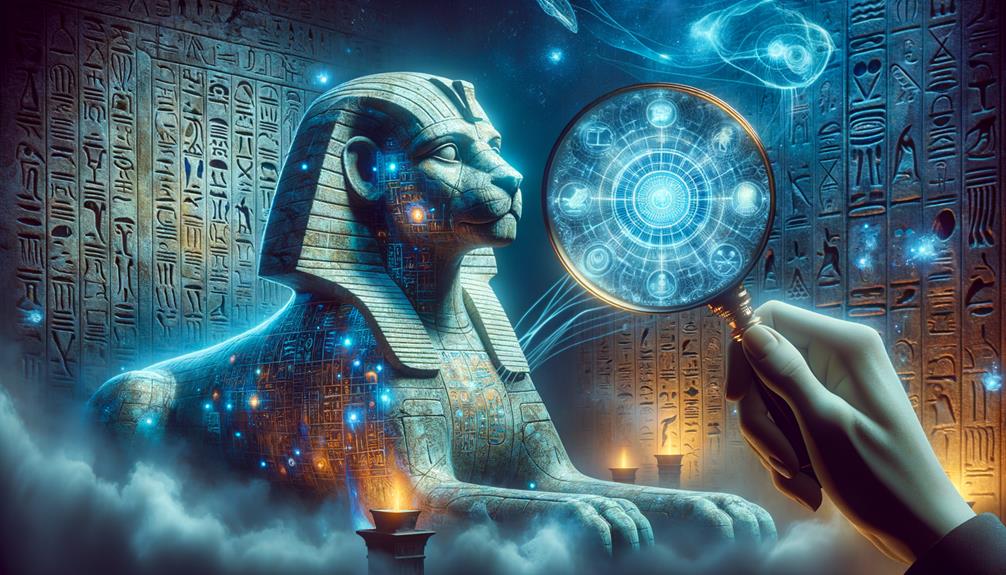
Alright, let's dive into the mystery of the Sphinx's riddles. It's a task as huge as the statue itself, asking us to dip our toes into the tangled worlds of mythology, archaeology, and history. The grand Egyptian Sphinx is one of the world's most lasting enigmas. This gigantic, puzzling figure has presented the Riddle of the Great Sphinx for many years, a challenge to figure out its origin, function, and symbolism.
We're not the only ones curious about the secrets of the Egyptian Sphinx. Scholars such as Mark Lehner have spent years decoding the Sphinx riddles, revealing secrets hidden beneath its limestone face. Yet, our understanding is still incomplete, much like the Sphinx's weather-damaged face.
In our effort to understand this enigma, let's consider three main aspects:
| Riddle | Interpretation | Significance |
|---|---|---|
| Man or Beast? | Sphinx as a symbol of royalty, power | Reflects ancient beliefs, societal structures |
| Lost Origins | Unknown builders, function | Tests our knowledge of ancient history |
| Hidden Passages | Alterations made after construction | Indicates changing uses, interpretations |
Figuring out these riddles is more than just an academic game. It's a trip into the core of a civilization that has forever influenced our world. So, let's continue to dig deeper, in search of truth in the sands of time.
Sphinx: The Guardian Figure
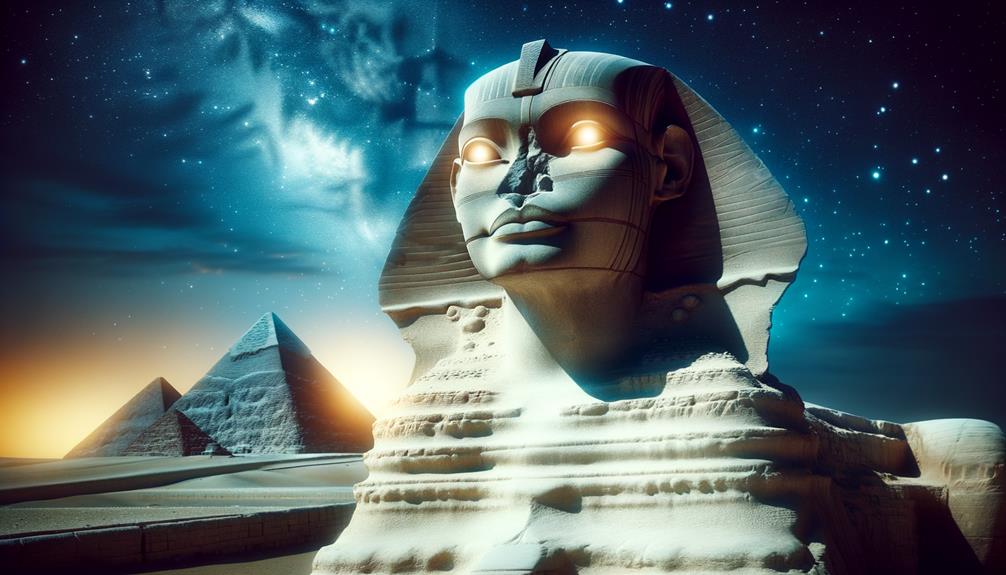
Let's talk about the Sphinx, not as a mere extraordinary monolith, but as a silent watchman steeped in a rich and enigmatic history that remains a fascination for scholars and history enthusiasts. This colossal statue from ancient Egypt, one of the biggest and oldest of its kind, stands as a testament to the brilliance and skill of its makers.
- A popular belief is that the Sphinx was conceived as a guardian of the Pyramid of Khafre (which belongs to Pharaoh Khafre) as well as the Great Pyramid of Khufu. It personifies the strength and wisdom of these ancient leaders.
- As for the face of the Sphinx, some suggest it was designed to represent Pharaoh Khafre himself. Its once vividly colored surface mirrored the power of the sun god in its vibrant shades.
- The Sphinx's relationship with Thutmose IV, as indicated by the 'Dream Stele' strategically placed between its paws, underlines its role as a guardian figure. Thutmose IV's reign is remembered for the restoration of the Sphinx, which he undertook because he believed the Sphinx had asked him to do so in a dream.
These Egyptian statues offer more than just a glimpse into ancient artistry; they represent a long-lasting legacy of a civilization that never ceases to amaze us with its grandeur and enigma.
The Missing Noses Mystery
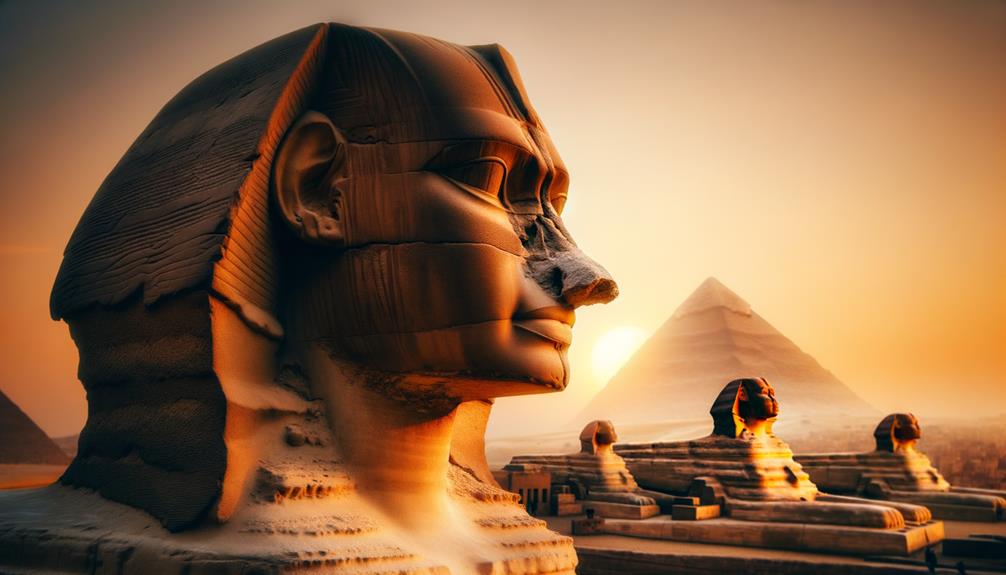
The mystery surrounding the missing nose of the Sphinx is something that grabs our interest. This mammoth structure, one of the biggest in the world, is an awe-inspiring sight. It's carved from a single stone and represents a human head on a lion's body. However, the nose that once graced this regal human face no longer exists.
There are numerous speculations about why the Sphinx doesn't have this vital facial feature. One theory that a lot of people believe is that the Sphinx's nose was intentionally removed using stone hammers. This act of destroying images of religious or political significance is a common occurrence in history, possibly during times of religious or political turmoil.
Another theory, backed by extensive academic study, suggests that the nose was lost due to natural wear and tear. But the actual reason is still a mystery. This unresolved question adds to the charm of the Sphinx, whose original name, 'Abu al-Hawl' or 'Father of Terror', only intensifies the mystery.
Examining the missing nose of the Sphinx not only arouses our interest but also encourages us to learn more about the complex weave of history. It's a reminder that the Sphinx, with its quiet stone stare, still keeps many secrets.
The Sphinx in Global Mythology
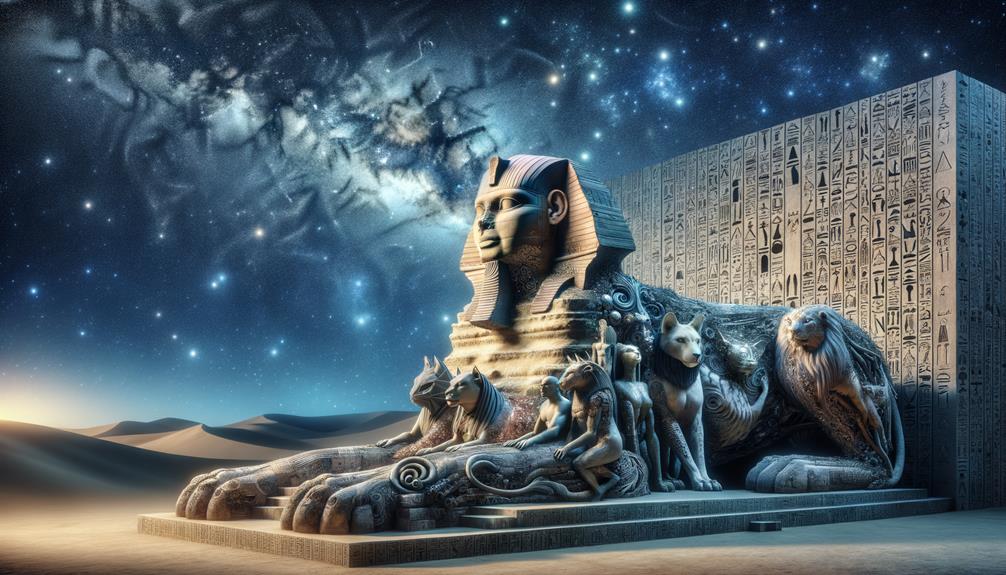
The Sphinx isn't just a colossal structure with an intriguing missing nose. It also carries a hefty weight in mythologies across the globe, from Greek legends to Hindu folktales and Asian cultural narratives. Originating from the Old Kingdom of Egypt, its roots go back thousands of years as attested by egyptologists such as Mark Lehner.
- For the Greeks, the Sphinx often showed up in puzzling stories, the most famous being the tale of Oedipus. Unlike its Egyptian sibling, the Greek Sphinx is often painted as a ruthless entity, symbolizing wisdom and death.
- In Hindu myths, the Sphinx, or 'purushamriga', is usually seen near temple entrances, serving as a protective figure. This creature is highly respected and seen as a representation of dharma.
- In Asian cultures, figures that resemble the Sphinx are commonly found guarding sacred sites, emphasizing their universal function as protectors.
Regardless if it's the Old Kingdom or the New Kingdom, the mythology of the Sphinx has crossed both time and geographical boundaries, reinforcing its global impact. It stands as proof of the lasting influence of myth and our shared fascination for mysteries.
Frequently Asked Questions
What Are the Secrets of the Sphinx?
So, what's the real deal with the Sphinx? Well, it's pretty much anyone's guess. This mammoth statue's actual name and the purpose behind its construction are still up in the air. But, even after it has faced the test of time and acts of destruction, its otherworldly appeal continues to draw in researchers and fans from all over.
Is There Anything Under the Sphinx?
You know, it's pretty fascinating. According to the work done by Mark Lehner, it appears there might be a sort of tunnel in the backside of the Sphinx. This suggests that some digging might have occurred after the monument was built. But honestly, what's hiding under the Sphinx is still a big question mark for most of us.
What Is Odd About the Great Sphinx?
Isn't it peculiar about the Great Sphinx, its origins and purpose shrouded in mystery? We're not certain of its original name or the reasons prompting its construction. What makes it even more intriguing is its colossal size, as it's one of the largest monolithic statues globally, crafted from just one block of limestone.
What Is the Great Sphinx Missing?
You know, it's quite fascinating that the Great Sphinx, that colossal statue from ancient times, is missing its nose! But the real kicker? We're not exactly sure why it's gone. Many folks think it didn't just fall off or erode over time, but that someone intentionally got rid of it a long, long time ago. Isn't that something?

